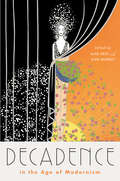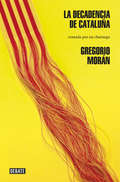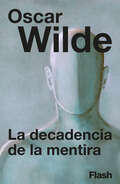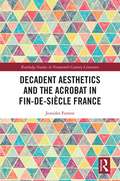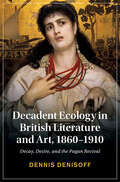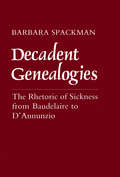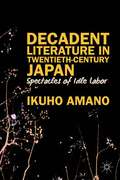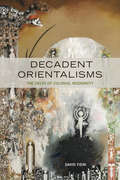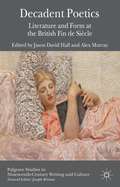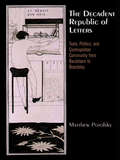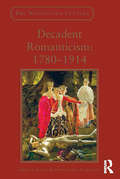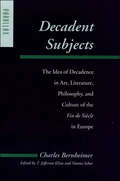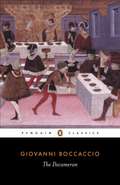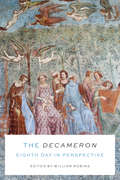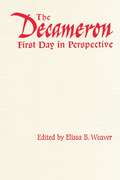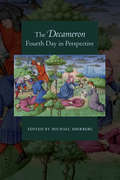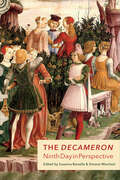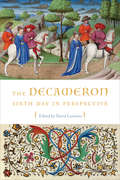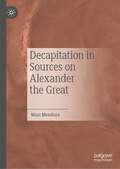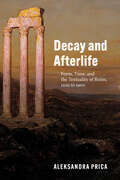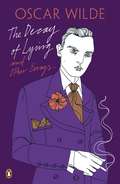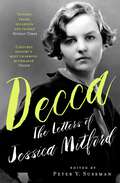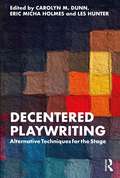- Table View
- List View
Decadence in the Age of Modernism (Hopkins Studies in Modernism)
by Kate Hext & Alex MurrayThe first holistic reappraisal of the significance of the decadent movement, from the 1900s through the 1930s.Decadence in the Age of Modernism begins where the history of the decadent movement all too often ends: in 1895. It argues that the decadent principles and aesthetics of Oscar Wilde, Walter Pater, Algernon Swinburne, and others continued to exert a compelling legacy on the next generation of writers, from high modernists and late decadents to writers of the Harlem Renaissance. Writers associated with this decadent counterculture were consciously celebrated but more often blushingly denied, even as they exerted a compelling influence on the early twentieth century. Offering a multifaceted critical revision of how modernism evolved out of, and coexisted with, the decadent movement, the essays in this collection reveal how decadent principles infused twentieth-century prose, poetry, drama, and newspapers. In particular, this book demonstrates the potent impact of decadence on the evolution of queer identity and self-fashioning in the early twentieth century. In close readings of an eclectic range of works by Virginia Woolf, James Joyce, and D. H. Lawrence to Ronald Firbank, Bruce Nugent, and Carl Van Vechten, these essays grapple with a range of related issues, including individualism, the end of Empire, the politics of camp, experimentalism, and the critique of modernity. Contributors: Howard J. Booth, Joseph Bristow, Ellen Crowell, Nick Freeman, Ellis Hanson, Kate Hext, Kirsten MacLeod, Kristin Mahoney, Douglas Mao, Michèle Mendelssohn, Alex Murray, Sarah Parker, Vincent Sherry
La decadencia de Cataluña: Contada por un charnego
by Gregorio MoránEl incisivo retrato de la evolución de la sociedad catalana en los últimos 20 años por un observador privilegiado. «La decadencia de Cataluña abarca diecisiete años de historia, un total de cuarenta y seis textos que definen el presente de este país que ahora es el mío porque yo lo decidí; un privilegio del que no gozan la mayoría de los autóctonos, obligados a vivir allí donde los parió su madre, les guste o no. De ahí el orgullo de "charnego", expresión utilizada para quien vino a trabajar a Cataluña. En mi caso no tiene el más mínimo sentido lo de sentirse integrado en la sociedad donde se vive, cosa que tampoco me ocurriría en París, Roma o Lisboa, porque no aspiro a ser "charnego agradecido". Ni ellos me regalan nada ni yo les bendigo por su benevolencia. Cada cual cumple con su trabajo y su responsabilidad como ciudadano. Punto.»
La decadencia de la mentira
by Oscar WildeUna defensa del arte por el arte clave para descubrir el pensamiento y la estética de Oscar Wilde. El arte ha caído en la cárcel del realismo y ha perdido toda la libertad creativa. Y, para huir de este culto a los hechos, es necesario reivindicar el papel de la mentira y el artificio en las obras. Mediante un diálogo repleto de paradojas y de la ironía característica del autor, Oscar Wilde evidencia la necesidad de escapar de toda intención moralizadora en la obra artística. Puesto que no hay nada más real que el arte, este debe existir por sí mismo y evitar ser un reflejo de una realidad que no haría más que corromperlo. «Oscar Wilde tiene el poder de transformar el ensayo en ficción.» Luis Antonio De Villen
Decadent Aesthetics and the Acrobat in French Fin de siècle (Routledge Studies in Nineteenth Century Literature)
by Jennifer ForrestIn his discussion of clowns in nineteenth-century French painting from Jean-Léon Gérôme’s 1857 La Sortie du bal masqué to Georges Rouault, art historian Francis Haskell wondered why they are so sad. The myth of the sad clown as an allegory for the unappreciated artist found echoes in the work of literary counterparts like Charles Baudelaire and his "Vieux saltimbanque" who seeks in vain a responsive public. For some, the attraction of the acrobatic clown for the creative imagination may have been his ability to embody the plight of the artist: these artistes generally led an ambulatory and uncertain existence. Other artists and writers, however, particularly the Decadents, perceived in the circus acrobat – including the acrobatic clown – a conceptual and performative tool for liberating their points of view from the prison-house of aesthetic convention. If authors’ protagonists were themselves sometimes failures, their aesthetic innovations often produced exhilarating artistic triumphs. Among the works examined in this study are the circus posters of Jules Chéret, Thomas Couture’s Pierrot and Harlequin paintings, Honoré Daumier’s saltimbanque paintings, Edgar Degas’s Miss Lala au Cirque Fernando, Édouard Manet’s Un bar au Folies-Bergère, the pantomimes of the Hanlon-Lees troupe, and novels, short stories, and poems by Théodore de Banville, Edmond de Goncourt, J. K. Huysmans, Gustave Kahn, Jules Laforgue, Catulle Mendès, Octave Mirbeau, Jean Richepin, Edouard Rod, and Marcel Schwob.
Decadent Ecology in British Literature and Art, 1860–1910: Decay, Desire, and the Pagan Revival (Cambridge Studies in Nineteenth-Century Literature and Culture)
by Dennis DenisoffCasting fresh light on late nineteenth- and early twentieth-century British art, literature, ecological science and paganism, Decadent Ecology reveals the pervasive influence of decadence and paganism on modern understandings of nature and the environment, queer and feminist politics, national identities, and changing social hierarchies. Combining scholarship in the environmental humanities with aesthetic and literary theory, this interdisciplinary study digs into works by Simeon Solomon, Algernon Swinburne, Walter Pater, Robert Louis Stevenson, Vernon Lee, Michael Field, Arthur Machen and others to address trans-temporal, trans-species intimacy; the vagabondage of place; the erotics of decomposition; occult ecology; decadent feminism; and neo-paganism. Decadent Ecology reveals the mutually influential relationship of art and science during the formulation of modern ecological, environmental, evolutionary and trans-national discourses, while also highlighting the dissident dynamism of new and recuperative pagan spiritualities - primarily Celtic, Nordic-Germanic, Greco-Roman and Egyptian - in the framing of personal, social and national identities.
Decadent Genealogies: The Rhetoric of Sickness from Baudelaire to D'Annunzio
by Barbara SpackmanBarbara Spackman here examines the ways in which decadent writers adopted the language of physiological illness and alteration as a figure for psychic otherness. By means of an ideological and rhetorical analysis of scientific as well as literary texts, she shows how the rhetoric of sickness provided the male decadent writer with an alibi for the occupation and appropriation of the female body.
Decadent Literature In Twentieth-century Japan
by Ikuho AmanoDecadence is a concept that designates a given historical moment as a phase of decay and valorizes the past as an irretrievable golden age. This study offers an innovative examination of a century of Japanese fiction through the analytical prism of decadence.
Decadent Orientalisms: The Decay of Colonial Modernity
by David FieniDecadent Orientalisms presents a sustained critique of the ways Orientalism and decadence have formed a joint discursive mode of the imperial imagination. Attentive to historical and literary configurations of language, race, religion, and power, Fieni shows the importance of understanding Western discourses of Eastern decline and obsolescence together with Arab and Islamic responses in which the language of decadence returns as a characteristic of the West.Taking seriously Edward Said’s claim that Orientalism is a “style of having power,” Fieni works historically through the aesthetic and ideological effects of Orientalist style, showing how it is at once comparative, descriptive, and performative. Orientalism, the book argues, relies upon decadence as the figure through which its positivist scientific claims become redistributed as speech acts—“truths” that establish dominance. Rather than attending to Orientalism as a repertoire of clichés and stereotypes, Decadent Orientalisms considers the systemic epistemological consequences of the diffuse, yet coherent network of institutions that have constituted Orientalism’s power.
Decadent Poetics
by Jason David Hall Alex MurrayDecadent Poetics has gathered together some of the most important scholars working in Victorian studies, with the ten essays here exploring the complex and vexed topic of decadent literature's formal characteristics. Invigorated by shifts in Victorian studies over the past ten years, this collection interrogates previously held assumptions around the nature of decadent form. The term 'poetics' conveys here not just the prosodic, but the multiplicitous forms of cultural production across the fin de siecle. From perfume to the post-human, theatre to attenuated textualities, these essays explore the ways in which the literary intersects with its others in the period. The range of writers studied here moves from those who now constitute a decadent canon - Oscar Wilde, 'Michael Field', Charles Baudelaire, Algernon Charles Swinburne and Ernest Dowson - to those whose work still inhabits the scholarly margins: A. E. Housman, Arthur Machen, Hubert Crackanthorpe and Graham R. Tomson. "
The Decadent Republic of Letters
by Matthew PotolskyWhile scholars have long associated the group of nineteenth-century French and English writers and artists known as the decadents with alienation, escapism, and withdrawal from the social and political world, Matthew Potolsky offers an alternative reading of the movement. In The Decadent Republic of Letters, he treats the decadents as fundamentally international, defined by a radically cosmopolitan ideal of literary sociability rather than an inward turn toward private aesthetics and exotic sensation.The Decadent Republic of Letters looks at the way Charles Baudelaire, Théophile Gautier, and Algernon Charles Swinburne used the language of classical republican political theory to define beauty as a form of civic virtue. The libertines, an international underground united by subversive erudition, gave decadents a model of countercultural affiliation and a vocabulary for criticizing national canon formation and the increasing state control of education. Decadent figures such as Joris-Karl Huysmans, Walter Pater, Vernon Lee, Aubrey Beardsley, and Oscar Wilde envisioned communities formed through the circulation of art. Decadents lavishly praised their counterparts from other traditions, translated and imitated their works, and imagined the possibility of new associations forged through shared tastes and texts. Defined by artistic values rather than language, geography, or ethnic identity, these groups anticipated forms of attachment that are now familiar in youth countercultures and on social networking sites.Bold and sophisticated, The Decadent Republic of Letters unearths a pervasive decadent critique of nineteenth-century notions of political community and reveals the collective effort by the major figures of the movement to find alternatives to liberalism and nationalism.
Decadent Romanticism: 1780-1914
by Kostas Boyiopoulos Mark SandyFor Decadent authors, Romanticism was a source of powerful imaginative revisionism, perversion, transition, and partial negation. But for all these strong Decadent reactions against the period, the cultural phenomenon of Decadence shared with Romanticism a mutual distrust of the philosophy of utilitarianism and the aesthetics of neo-Classicism. Reflecting on the interstices between Romantic and Decadent literature, Decadent Romanticism reassesses the diverse and creative reactions of Decadent authors to Romanticism between 1780 and 1914, while also remaining alert to the prescience of the Romantic imagination to envisage its own distorted, darker, perverted, other self. Creative pairings include William Blake and his Decadent critics, the recurring figure of the sphinx in the work of Thomas De Quincey and Decadent writers, and Percy Shelley with both Mathilde Blind and Swinburne. Not surprisingly, John Keats’s works are a particular focus, in essays that explore Keats’s literary and visual legacies and his resonance for writers who considered him an icon of art for art’s sake. Crucial to this critical reassessment are the shared obsessions of Romanticism and Decadence with subjectivity, isolation, addiction, fragmentation, representation, romance, and voyeurism, as well as a poetics of desire and anxieties over the purpose of aestheticism.
Decadent Subjects: The Idea of Decadence in Art, Literature, Philosophy, and Culture of the Fin de Siècle in Europe (Parallax: Re-visions of Culture and Society)
by Charles BernheimerHonorable Mention for the Aldo and Jeanne Scaglione Prize for Comparative Literary Studies from the Modern Language AssociationCharles Bernheimer described decadence as a "stimulant that bends thought out of shape, deforming traditional conceptual molds." In this posthumously published work, Bernheimer succeeds in making a critical concept out of this perennially fashionable, rarely understood term.Decadent Subjects is a coherent and moving picture of fin de siècle decadence. Mature, ironic, iconoclastic, and thoughtful, this remarkable collection of essays shows the contradictions of the phenomenon, which is both a condition and a state of mind. In seeking to show why people have failed to give a satisfactory account of the term decadence, Bernheimer argues that we often mistakenly take decadence to represent something concrete, that we see as some sort of agent. His salutary response is to return to those authors and artists whose work constitutes the topos of decadence, rereading key late nineteenth-century authors such as Nietzsche, Zola, Hardy, Wilde, Moreau, and Freud to rediscover the very dynamics of the decadent. Through careful analysis of the literature, art, and music of the fin de siècle including a riveting discussion of the many faces of Salome, Bernheimer leaves us with a fascinating and multidimensional look at decadence, all the more important as we emerge from our own fin de siècle.
Decadent Subjects: The Idea of Decadence in Art, Literature, Philosophy, and Culture of the Fin de Siècle in Europe (Parallax: Re-visions Of Culture And Society Ser.)
by Charles BernheimerAn illuminating exploration of fin de siècle decadence “by a well-known authority in the areas of European literature, culture, and psychoanalysis” (Pre-Raphaelite Studies).The influential writer and scholar Charles Bernheimer described decadence as a “stimulant that bends thought out of shape, deforming traditional conceptual molds.” In this posthumously published work, Bernheimer succeeds in making a critical concept out of this perennially fashionable, rarely understood term.This remarkable collection of essays shows the contradictions of the phenomenon, which is both a condition and a state of mind. In seeking to show why people have failed to give a satisfactory account of the term decadence, Bernheimer argues that we often mistakenly take decadence to represent something concrete, that we see as some sort of agent. His salutary response is to return to those authors and artists whose work constitutes the topos of decadence, rereading key late nineteenth-century authors such as Nietzsche, Zola, Hardy, Wilde, Moreau, and Freud to rediscover the very dynamics of the decadent. Through careful analysis of the literature, art, and music of the fin de siècle—including a riveting discussion of the many faces of Salome—Bernheimer leaves us with a fascinating and multidimensional look at decadence.Honorable Mention for the Aldo and Jeanne Scaglione Prize for Comparative Literary Studies from the Modern Language Association
The Decameron
by Giovanni BoccaccioIn the summer of 1348, as the Black Death ravages their city, ten young Florentines take refuge in the countryside...Taken from the Greek, meaning 'ten-day event', Boccaccio's Decameron sees his characters amuse themselves by each telling a story a day, for the ten days of their confinement - a hundred stories of love and adventure, life and death, and surprising twists of fate. Less preoccupied with abstract concepts of morality or religion than earthly values, the tales range from the bawdy Peronella, hiding her lover in a tub, to Ser Cepperallo, who, despite his unholy effrontery, becomes a Saint. The result is a towering monument of European literature and a masterpiece of imaginative narrative that has inspired writers from Chaucer to Shakespeare . Translated with an introduction by G.H. McWilliam'McWilliam's finest work, his translation of Boccaccio's Decameron remains one of the most successful and lauded books in the series'The Times
The Decameron Eighth Day in Perspective (Toronto Italian Studies)
Divided into ten days of ten novellas each, Boccaccio’s Decameron is one of the literary gems of the fourteenth century. The Decameron Eighth Day in Perspective is an interpretive guide to the stories of the text’s Day Eight – a day dedicated to tales of tricks and practical jokes. By drawing on literary precursors such as fabliaux, epic, philosophy, exempla, Dante’s Commedia, and scripture, and by meditating on the dynamics of civic engagement in fourteenth-century Florence, Boccaccio develops in these stories of jests a self-consciously literary representation of the Florentine social imaginary. The essays in this volume, all written by prominent scholars, survey previous scholarship and open up new cultural and historical perspectives on Boccaccio’s sophisticated art of storytelling. They analyze both the literary sources that Boccaccio’s comic narratives transform, as well as the political, legal, and ethical contexts with which they engage. Each contributor tackles a single tale, yet their essays also register major themes and concerns that recur throughout Day Eight, allowing for close connections among the essays.
The Decameron First Day in Perspective: The Lectura Boccaccii (The Royal Society of Canada Special Publications)
by Elissa B. WeaverGiovanni Boccaccio's Decameron is the best known and most read work in Italian literature next to Dante's Divine Comedy. In the tradition of Lectura Dantis, the practice of story-by-story critical readings of Dante's work, Elissa Weaver has collected essays from some of the most prominent American Boccaccio scholars to provide critical readings of the Decameron Proem, Introduction, and the ten stories that constitute the first of the ten 'days' of storytelling.The first of the twelve essays opens the volume with a consideration of the Proem, demonstrating the importance of Boccaccio's literary subtexts (Ovidian and Dantean) for understanding his poetics. The second essay, on the Introduction, discusses the title of the work and the framing tale. The remaining ten contributions treat in detail each story, examining the literary, ethical, and social concerns embodied in the short narratives and in the context provided by the comments and discussions of the story-tellers, and exploring the intertextual relations within the Decameron and with sources and analogues. This inaugural book in a new series of critical essays on the Decameron will provide an important guide to reading the complex series of narratives that constitute the opening of the Decameron and will serve as a guide to reading the entire work.
The Decameron Fourth Day in Perspective (Toronto Italian Studies)
by Michael SherbergThis volume, part of the Lectura Boccaccii series organized by the American Boccaccio Association, offers close readings by top scholars of Day Four of the Decameron. As fans of the Decameron know, the Fourth Day opens with an important intervention in which the author defends his project against his critics, which coincides with a significant change in tone as the subject matter turns to stories with unhappy endings. The contributors approach the stories from a variety of perspectives, including the linguistic, philosophical, anthropological, and literary historical. These fresh readings of stories that are nearly seven hundred years old testify to the enduring power of Boccaccio’s masterpiece to speak to new audiences and to find compelling relevance even at a great distance from its immediate medieval context.
The Decameron Ninth Day in Perspective (Toronto Italian Studies)
by Susanna Barsella Simone MarchesiThe Ninth Day of Giovanni Boccaccio’s Decameron is significant both for numerological and structural reasons. Whether we consider the Decameron as reproducing an itinerary toward the attainment of virtue or following other possible interpretive schematics, Day Nine remains a liminal moment of pause before the inception of the final stories dedicated to the highest civic virtues of liberality and magnificence. This collection is comprised of extensive and rigorous essays by leading experts in the field of Boccaccio studies and medieval literature, shedding new critical light on the Ninth Day. The volume incorporates a multitude of disciplinary perspectives including literary studies, visual arts, political history, and gender studies. Taking a holistic approach, the contributors to the volume trace the dense and multi-layered web of interrelations between the narrative units and the rest of the Decameron. Connections between individual stories are highlighted and interactions between Day Nine and its counterparts in the book are analysed. In doing so, The Decameron Ninth Day in Perspective synthesizes existing scholarship but also opens up new horizons for future work.
The Decameron Sixth Day in Perspective (Toronto Italian Studies)
by David LummusThe Sixth Day of Giovanni Boccaccio’s Decameron marks a new beginning. Its first story is the structural centre of the one hundred tales and signals the start of the day’s reflection on the power of the word as the fundamental building block of human communication. This collection gathers together readings of each of the ten stories in Day Six of the Decameron – the shortest of the entire work. Featuring a diverse group of literary scholars whose expertise is not limited to Boccaccio studies, the collection offers both comprehensive accounts of the tales and new interpretations of their significance. A major contribution to the study of the Decameron, it will also serve as an excellent starting point for new readers of Boccaccio’s masterpiece. The readings demonstrate how Boccaccio engaged in rethinking or elaborating on the heritage of Western literature and thought, including the Bible; the works of Dante; the Roman literary, rhetorical, and legal tradition; the writings of the Church Fathers; and the ideas of scholastic theologians. These lecturae employ a range of methodologies that account for both historical and theoretical issues in their engagement with Boccaccio's poetic and ethical project in the Decameron.
The Decameron Third Day in Perspective
by Pier Massimo Forni Francesco CiabattoniDivided into ten days of ten novellas each, Giovanni Boccaccio's Decameron is one of the literary gems of the fourteenth century. The 'Decameron' Third Day in Perspective is an interpretive guide to the stories of the text's Third Day. For each novella, a distinguished Boccaccio scholar offers an essay that both reviews the current scholarly literature and advances new and intriguing interpretations of the work. The whole collection reflects the series's guiding principle of examining the text "in perspective," revealing the connections among the novellas, the Days, and the framing narrative that holds the whole Decameron together.The second of the University of Toronto Press's interpretive guides to Boccaccio's Decameron, this collection forms part of an ambitious project to examine the entire Decameron, Day by Day.
Decapitation in Sources on Alexander the Great
by Marc MendozaThis book explores cases of decapitation found in sources on the reign of Alexander the Great. Despite the enormous literature on the career of Alexander the Great, this is the first study on the characterisation of violent deaths during his hectic reign. This historiographical omission has involved the tacit and blind acceptance of the details found in the ancient sources. Therefore, this book seeks to illustrate how cultural expectations, literary models, and ideological taboos shaped these accounts and argues for a close and critical reading of the sources. Given the different cultural considerations surrounding decapitation in Greek and Roman cultures, this book illustrates how those biases could have differently shaped certain episodes depending on the ultimate writer.This book, therefore, can be especially interesting for scholars focused on the career of Alexander the Great, but also valuable for other Classicists, philologists, and even for anthropologists because it represents a good case of study of cultural symbolism of violent death, semantics of power, imperial domination and the confrontation between opposite cultural appreciations of a practice.
Decay and Afterlife: Form, Time, and the Textuality of Ruins, 1100 to 1900
by Aleksandra PricaCovering 800 years of intellectual and literary history, Prica considers the textual forms of ruins. Western ruins have long been understood as objects riddled with temporal contradictions, whether they appear in baroque poetry and drama, Romanticism’s nostalgic view of history, eighteenth-century paintings of classical subjects, or even recent photographic histories of the ruins of postindustrial Detroit. Decay and Afterlife pivots away from our immediate, visual fascination with ruins, focusing instead on the textuality of ruins in works about disintegration and survival. Combining an impressive array of literary, philosophical, and historiographical works both canonical and neglected, and encompassing Latin, Italian, French, German, and English sources, Aleksandra Prica addresses ruins as textual forms, examining them in their extraordinary geographical and temporal breadth, highlighting their variability and reflexivity, and uncovering new lines of aesthetic and intellectual affinity. Through close readings, she traverses eight hundred years of intellectual and literary history, from Seneca and Petrarch to Hegel, Goethe, and Georg Simmel. She tracks European discourses on ruins as they metamorphose over time, identifying surprising resemblances and resonances, ignored contrasts and tensions, as well as the shared apprehensions and ideas that come to light in the excavation of these discourses.
The Decay of Lying: And Other Essays
by Oscar WildeIn 'The Decay of Lying' Oscar Wilde uses his decadent ideology in an attempt to reverse and therefore reject his audiences' 'normal' conceptualizations of nature, art and morality. Wilde's views of life and art are illustrated through the use of Platonic dialogue where the character Vivian takes on the persona of Wilde. Wilde's goal is to subvert the norm by reversing its values. Wilde suggests to us that society is wrong, not him. Calling on diverse examples - from Ancient Greek sculpture to contemporary paintings - Oscar Wilde's brilliant essay creates a witty, paradoxical world in which the only Art worth loving is that built on complete untruths.
Decca: The Letters of Jessica Mitford
by Jessica Mitford'These letters are a treat ... as an example of what a woman can do once she has rid herself of, or at least decided to ignore, the expectations of others - family, men, society - Jessica Mitford will always take some beating' OBSERVER'Captures history's most charming muckraker, from her friendships with Katharine Graham and Maya Angelou to her devotion to civil rights' VOGUE'Jessica Mitford is a sister of mine. If I had to go into a room with a leopard, I wouldn't hesitate to ask for her' Maya AngelouOver her 78 years, Decca's letters reveal a remarkable life - from her childhood as the daughter of a British peer to her scandalous elopement to the Spanish Civil War with her cousin, to her life in the USA, where she married a radical lawyer. The Mitford girls included Diana (who married the British fascist leader Oswald Mosley), Unity (who was close to Adolf Hitler) and Debo (who became the Duchess of Devonshire). Decca shocked them all when she joined the American Communist Party. Her letters are the stories of a century: gossip and politics, war and mores, the wonders of rapid technological change, the poignancy of personal struggles. They are also a record of her never-ending quest for social justice. This is a fascinating collection that reveals to us intimately the most ebullient Mitford of them all.
Decentered Playwriting: Alternative Techniques for the Stage
by Carolyn M. DunnDecentered Playwriting investigates new and alternative strategies for dramatic writing that incorporate non-Western, Indigenous, and underrepresented storytelling techniques and traditions while deepening a creative practice that decenters hegemonic methods. A collection of short essays and exercises by leading teaching artists, playwrights, and academics in the fields of playwriting and dramaturgy, this book focuses on reimagining pedagogical techniques by introducing playwrights to new storytelling methods, traditions, and ways of studying, and teaching diverse narratological practices. This is a vital and invaluable book for anyone teaching or studying playwriting, dramatic structure, storytelling at advanced undergraduate and graduate levels, or as part of their own professional practice.
